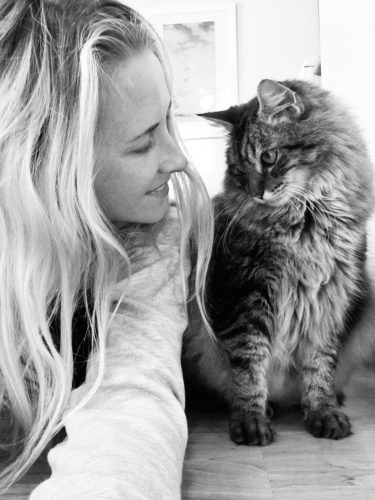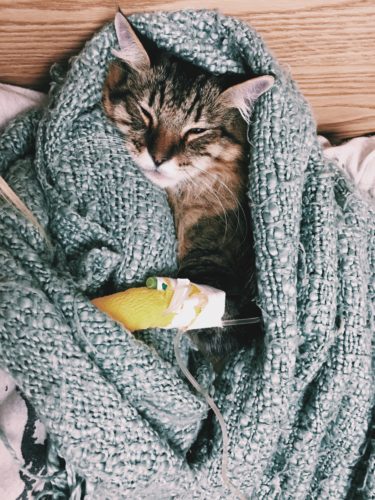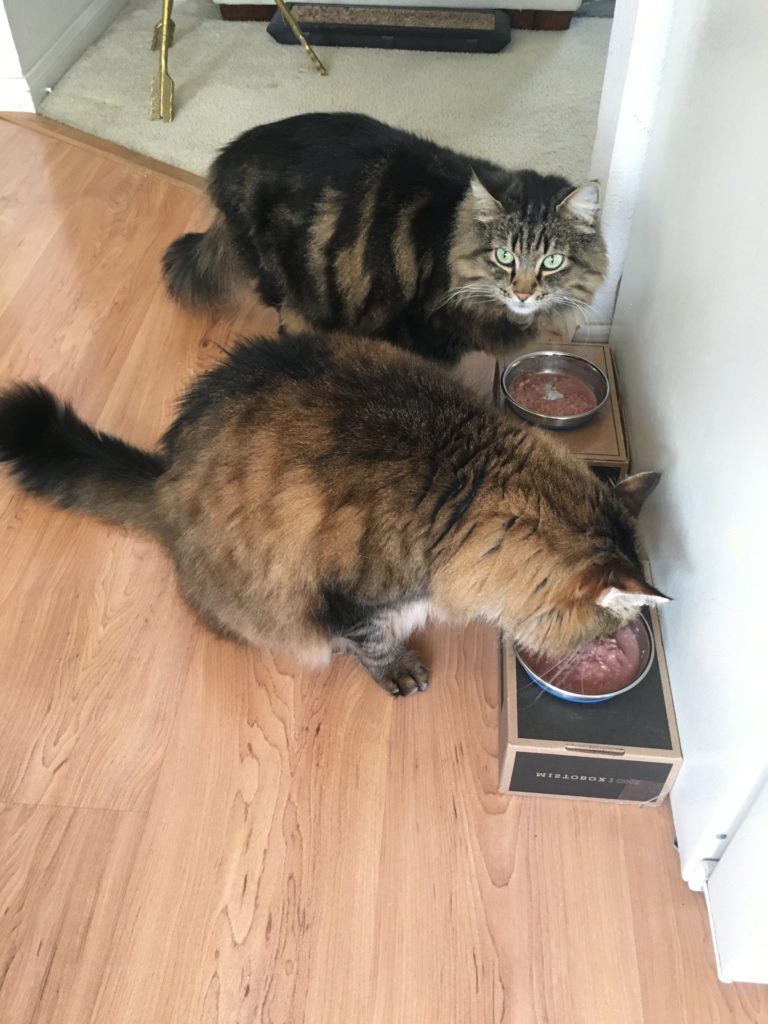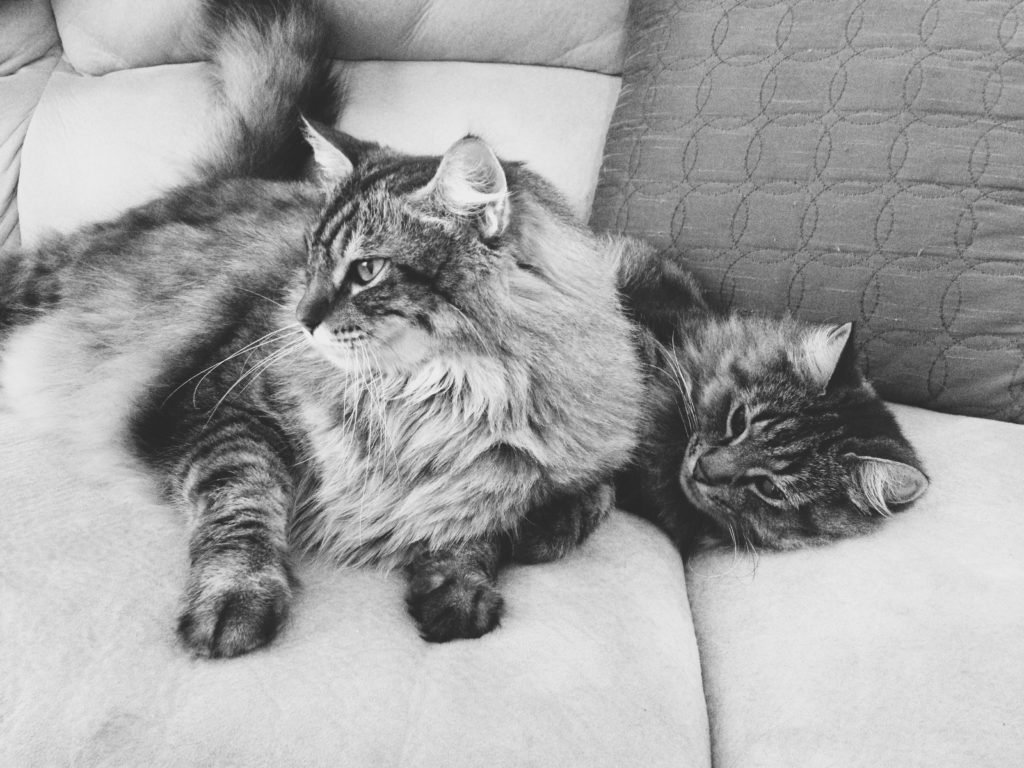This post is part of our “Journey to Raw” series, published on Wednesdays, and comes to you from Amy Ripplinger, a devoted cat mom and fresh feeding advocate who enjoys snuggling her two kittos and traveling the world with her boyfriend. You can follow their journeys @BellsandJazz on Instagram.
 I’ve been a crazy cat lady for the majority of my life. I LOVE cats. I love every single thing about them. And I thought I knew everything about them as well. Despite being a crazy cat lady for 30-some years, my knowledge of feline nutrition was severely lacking. At my vet’s recommendation, I fed my two cats, Jasper and Bella, Science Diet kibble and, on special occasions, canned food. This went on for the first 9 years of their lives … before I knew better.
I’ve been a crazy cat lady for the majority of my life. I LOVE cats. I love every single thing about them. And I thought I knew everything about them as well. Despite being a crazy cat lady for 30-some years, my knowledge of feline nutrition was severely lacking. At my vet’s recommendation, I fed my two cats, Jasper and Bella, Science Diet kibble and, on special occasions, canned food. This went on for the first 9 years of their lives … before I knew better.
My journey to raw began November 5, 2015. For a bit of background, my boy cat, Jasper, has always been a puker. Even at his annual check-ups, they’d ask how often he vomits and when I said a few times a month or more, they’d brushed it off with “well, that’s normal, especially for long-haired cats,” and give me a big tube of maple-flavored laxatone.
Jasper threw up the morning of November 5th. Not being anything out of the ordinary, I cleaned up the mess and left for work. When I returned a few hours later, I noticed two more spots of vomit. I paused and thought his tummy might be upset, and cleaned up the messes. Later that evening, he vomited again. I was getting worried. This was definitely not normal. Now on high alert, I watched him closely as he retreated to the closet to hide. I took him out and just sat with him. His body was listless and he was drooling. I immediately scooped him up and rushed him to the ER. This began a 5-day nightmare of endless tests and ups and downs resulting in a questionable outcome. The news was devastating. He had pancreatitis, inflammatory bowel disease (IBD), hypertrophic cardiomyopathy (HCM), and chronic kidney disease (CKD). How in the world did this happen to my poor cat?! With a handful of new prescriptions and follow-up vet appointments every four weeks, we were sent on our way.

In utter desperation to help Jasper, I researched everything I could about “the best food for cats” and what to do for all of the health issues he had been diagnosed with. I found several resources that discussed big box pet food companies and what is and is not appropriate for cats. I sat in disbelief, as what I read was shocking. VOMITING IN CATS IS NOT NORMAL. CATS SHOULD NOT EAT DRY FOOD. What?! Cats shouldn’t eat dry food?! But that’s all I’ve EVER fed my cats for my entire life?! I immediately threw out all the kibble I had on hand and went to the pet store on a mission to find a high-quality canned food. With my newfound knowledge, I tried to find something that listed protein as the first ingredient and didn’t contain any animal by-products, grain, corn, soy or other fillers, or carrageenan. Let me just tell you, that this was not an easy quest. With hundreds of cat food options, few offered what I needed.
The next few months were my journey to find something Jasper would eat. One day he would eat something with gusto but then not be interested in it the next. We went through numerous cans of cat food, trying different brands and proteins, even trying Limited Ingredient Diets for his finicky appetite and stomach. He would pick at his food, barely eating 2 ounces for the entire day, and his vomiting increased in frequency. He lost 3 pounds in a few short weeks and I was desperate to help him.
A website for cats with HCM mentioned feeding a “proper diet.” I contacted them for more information and was given details about raw diets and advised to join the raw feeding community to learn more. This led me to a Facebook Group called Raw Feeding for IBD Cats. I made a post describing my situation and asking for any advice. One of the admins quickly jumped at the opportunity to help and gave me ample resources for transitioning to a raw diet. I was a bit apprehensive to introduce raw meat to my boy’s already compromised little body, but raw diets kept coming up throughout my search for the best cat food and, with Jasper’s rapid decline, I had nothing to lose.
In February 2016, I started introducing raw very slowly with Rad Cat, a commercial raw food made with eggshell instead of bone, which is better for cats with CKD. I gave both kitties a dollop to test the waters. Jasper ate it, but Bella was not interested. I had to entice her by topping the raw food with some crushed up treats. She ate it! I then mixed a tiny bit of Rad Cat with their wet food for their meal. After each successful day of no vomiting or diarrhea, I increased the amount by 0.02 ounces until each meal was only raw food. I kept daily diaries and logged everything from food intake and bathroom habits to behavioral changes. I noted every detail so I could keep track of what, when, and how much they were eating and report anything of significance to Jasper’s new internal medicine specialist. This also gave me a good baseline of what was “normal” for each cat so I was more aware when things tipped in either direction.
 Taking two months to fully transition, both kitties were 100% raw-fed starting in April. It wasn’t a linear progression for the first few months. There were many ups and downs, but the changes were obvious and undeniable. It was the first time in months that Jasper had licked his bowl clean. The mere sight of an empty bowl was all the encouragement I needed to know I was doing the right thing. Jasper was starting to get his energy back and his overall demeanor was so much better. Bella was thriving as well. I hadn’t even realized she was overweight until I saw her newly trimmed form.
Taking two months to fully transition, both kitties were 100% raw-fed starting in April. It wasn’t a linear progression for the first few months. There were many ups and downs, but the changes were obvious and undeniable. It was the first time in months that Jasper had licked his bowl clean. The mere sight of an empty bowl was all the encouragement I needed to know I was doing the right thing. Jasper was starting to get his energy back and his overall demeanor was so much better. Bella was thriving as well. I hadn’t even realized she was overweight until I saw her newly trimmed form.
Over the next few months, I continued to feed a variety of Rad Cat proteins, slowly adding in the new proteins just as I had initially transitioned from canned food. I even made my own raw meals with a supplemental meat-completer created by the two founders of the Facebook group who kickstarted my journey to raw.
With the success of feeding commercial raw, by fall I was ready for my next mission: homemade meals! I continued to read as much as I could about raw feeding and creating a balanced raw diet. Through trial and error, I’m finding which proteins and offal they like and can tolerate (apparently Bella will NOT eat pork liver, that batch became a special one just for Jasper!). As intimidating as it was at first, I have found through practice and routine that it’s no more complicated than following a simple dinner recipe from Pinterest. While it’s not difficult, however, it is imperative to follow a balanced recipe to ensure proper nutrition values.
Just a few weeks shy of our 1-year transition anniversary, the kitties are now on a rotation of fully homemade meals of chicken, turkey, and pork mixed with the supplement. While Jasper still sometimes battles vomiting, his overall appearance and behavior has done a complete 180. A few weeks ago, Jasper had a follow-up with the cardiologist and the vet and vet techs all commented on his shiny coat. His blood work also came back with improved kidney values. Yay! Seeing these positive changes in both of my cats first-hand has made me an advocate for feeding a species-appropriate diet. I, for one, will never in my life feed commercial kibble or canned again. The difference between thriving and just surviving is literally life-changing. While I am still learning every day, the peace of mind I have knowing I am feeding the very best food possible is priceless.

If you feed your kitties a raw diet and would like to see your story featured here, please contact me or leave a comment below.
And if you‘re interested in giving raw a try, check out our Raw Feeding and Transitioning Your Cat to Raw sections, and join the CatCentric group for help and support during your transition.

